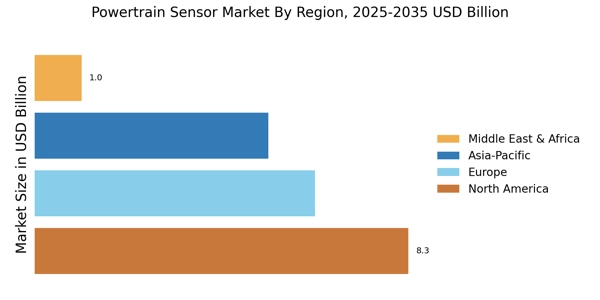The Powertrain Sensor Market is currently characterized by a dynamic competitive landscape, driven by technological advancements and increasing demand for efficient automotive solutions. Key players such as Robert Bosch GmbH (Germany), Continental AG (Germany), and Denso Corporation (Japan) are at the forefront, each adopting distinct strategies to enhance their market positioning. Robert Bosch GmbH (Germany) emphasizes innovation in sensor technology, focusing on developing advanced driver-assistance systems (ADAS) that integrate seamlessly with powertrain components. Meanwhile, Continental AG (Germany) is pursuing strategic partnerships to bolster its capabilities in electric vehicle (EV) powertrains, reflecting a broader industry shift towards electrification. Denso Corporation (Japan) is also investing heavily in research and development, particularly in the realm of hybrid and electric powertrains, which positions it favorably in a rapidly evolving market.
In terms of business tactics, companies are increasingly localizing manufacturing to reduce costs and enhance supply chain efficiency. This trend is particularly evident in regions with burgeoning automotive markets, where firms are establishing production facilities closer to their customer bases. The competitive structure of the Powertrain Sensor Market appears moderately fragmented, with several key players exerting substantial influence. This fragmentation allows for a diverse range of products and innovations, fostering a competitive environment that encourages continuous improvement and adaptation.
In August 2025, Denso Corporation (Japan) announced a collaboration with a leading EV manufacturer to develop next-generation powertrain sensors aimed at improving energy efficiency. This strategic move underscores Denso's commitment to advancing its technological capabilities in response to the growing demand for sustainable automotive solutions. By aligning with an established EV manufacturer, Denso not only enhances its product offerings but also positions itself as a key player in the electrification of the automotive sector.
Similarly, in September 2025, Continental AG (Germany) unveiled a new line of powertrain sensors designed specifically for hybrid vehicles. This launch reflects Continental's strategic focus on capturing market share in the hybrid segment, which is expected to see significant growth in the coming years. The introduction of these sensors is likely to enhance vehicle performance and fuel efficiency, thereby appealing to environmentally conscious consumers and manufacturers alike.
In October 2025, Robert Bosch GmbH (Germany) expanded its sensor technology portfolio by acquiring a startup specializing in AI-driven diagnostics for powertrain systems. This acquisition is indicative of Bosch's strategy to integrate artificial intelligence into its product offerings, enhancing the functionality and reliability of its sensors. By leveraging AI, Bosch aims to provide more sophisticated solutions that can predict maintenance needs and optimize performance, thereby setting a new standard in the powertrain sensor market.
As of October 2025, the competitive trends within the Powertrain Sensor Market are increasingly defined by digitalization, sustainability, and the integration of artificial intelligence. Strategic alliances are becoming more prevalent, as companies recognize the need to collaborate in order to innovate and meet evolving consumer demands. Looking ahead, it is anticipated that competitive differentiation will shift from traditional price-based competition to a focus on innovation, technological advancement, and supply chain reliability. This evolution suggests that companies that prioritize these aspects will likely emerge as leaders in the market.


















Leave a Comment